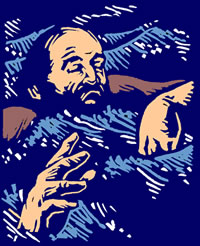
19th Sunday in Ordinary Time Year A
The people who gave us the scriptures had a very different outlook from ours. Because they had no doubt that miracles frequently occur, their traditions in the scriptures often make use of miracle stories to express their faith that God has been active in their history. Elijah was a 9th century prophet who profoundly influenced the faith of old Israel, teaching the incomparable greatness of the divine mystery. He is remembered through stories like that in today’s first reading. This story describes Elijah meeting the Lord at Mount Horeb (Sinai). Whereas God’s presence was shown to Moses at Sinai, through earthquake and fire, Elijah’s meeting was very different - in ‘the sound of a gentle breeze’. Clearly, such things as the wind’s shattering of rocks are contrived, to show how Elijah’s teaching about God went even beyond that of Moses. Historically, there is no doubt that Jesus worked miracles – raising people to life, and healing them in a manner that defied explanation. A very limited number of such events are recalled in the gospel narratives. Studies made of these narratives show that do not have the form of ‘wonder stories’ – the wonder is not emphasised; Jesus even discourages the awakening of popular enthusiasm, wanting those involved to recognise in faith that what has happened is a sign of the coming of the Kingdom he is proclaiming. The fact that this common pattern is not found in this narrative has led many interpreters to see the miraculous events of today’s gospel reading as a symbolic creation of early Christian teachers, expressing the lessons of Jesus for his disciples. This reading, we should recall, belongs to a narrative section of Matthew’s gospel describing the formation Jesus is giving to his disciples. Perhaps it is related to the story of the calming of the storm by Jesus, that Matthew has included in an earlier chapter (8:23-27).
Sudden storms are frequent on the Sea of Galilee. For the people of the Middle East, the waters of the sea were a mysterious and menacing element of creation, kept in place by divine power. They provided a ready symbol of forces hostile to God’s designs. This narrative is also found in the gospels of Mark and John. Neither of them, however, mentions the astonishing experience of Peter. In Matthew’s gospel, on the other hand, this incident is one of three that single out Peter’s place among the disciples (Mt 16:17-19; 17:24-27). Let us not be distracted by the question of the origin of this unusual narrative. As a symbolic account of the formation Jesus was giving it has great value for the Church of every generation.
Sending his disciples on their way, Jesus gives himself to prayer. Only his living relation with his Father explains the authority and serene courage that were so evident in his life. He invites us to learn from his example. The symbol of the Church as ‘the bark of Peter’ has long been part of Catholic awareness. Those in the boat are sustained by the words of Jesus, promising that, in the end, he will rejoin them, when they reach the shore to which he has directed them. More than that, they are assured that, despite the hostile forces of the sea and the deepest darkness of the night, they will experience the Saviour’s mysterious presence assisting them. His words, ‘It’s me! Don’t be afraid’, are the turning point in all three gospel accounts. In Matthew’s account, it is the inimitable Peter – the one who is to ‘strengthen his brothers’ in their doubts (Lk 22:31) - who leads the others to recognise the Lord’s presence, and make their confession of faith, ‘Truly, you are the Son of God’.
John Thornhill sm

